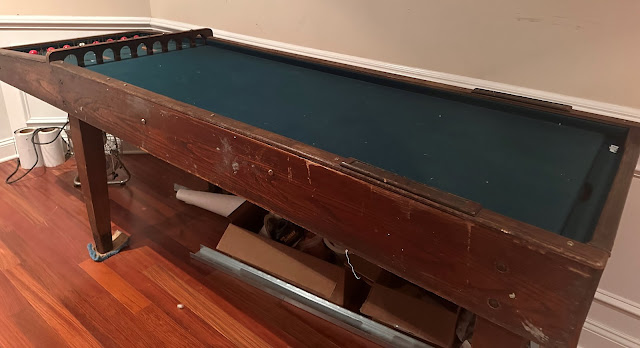Carombolette seems to have been a bit of a novelty billiards table. It took the "pigeon holes" / wooden gates / Mississippi bagatelle arches and introduced a tantalizing playground of pins and pockets you could apply some strategy to, but played heavily on chance. Perhaps a compromise between the erratic nature of slanted pintable bagatelle and the more traditional billiards games?
This also seems to an early appearance of the stationary bell on a larger table, centered in the highest scoring pockets so to ring when a ball enters it. Prior tables all have hanging bells that are chimed by the ball passing under. I wonder if this would have been influenced from the Redgrave parlor bagatelles that arrived in the late 1870s?
The slant of the back portion of the playfield ensures gravity takes over and absolute control by the player is a bit of an illusion. There was still a strong skill component in shooting the balls down the table and through the gates, but the randomness offers tantalization, and probably made it exceptionally fun for people to bet on.
To look at simpler bagatelles, go to this earlier post. And we look at slanted pintable bagatelles.
Note: this article we re-edited on 2025-03-17
The earliest confirmed date we have for Carombolette is 1881, via USA patent 0242584, filed by M. Bensinger.
 |
| USA patent 0242584 |
 |
| USA patent 0242584 |
 |
| USA patent 0242584 |
Rearranging those patent drawings...
Thanks to the wonderful Brunswick archives, the earliest ad copy we've seen so far is from this 1883 catalogue: J.M. Brunswick & Balke Co. The Most Extensive Manufacturers Of Billiard And Pool Tables And General Billiard Supplies. (archive)
 |
| these are from the 1883 Brunswick catalogue |
It would be fair to cast doubt on claims of carombolette tables from before 1881. To be honest For example...
This is a description given by the auction house. Please note that auction descriptions are NOTORIOUS for their inaccuracies. We have no evidence of the Count D'Artois having a pin bagatelle table, that's currently just a folk tale. Where did the auction house get the 1857 date? No one knows.
Montague Redgrave Bagatelle Company PARLOR BAGATE
1857. Impossible to find. This is the only one I have ever seen in the past 35 years of collecting. Complete restoration from top to bottom. This is the forerunner of pinball; first named around 1777 France, by King Louis 16ths brother Count D'Artois. This game has a Solid Slate playfield underneath the new felt covering. Redgrave was the first to make small games with a coil spring and a shooting rod which we now call the "ball shooter or plunger" which was patented in the USA. These games were so popular that he made larger ones like this particular model for Saloons and Beer Halls. This game was originally played with "Wickets" not Cue Sticks. This is a real find for the player and the historian alike. Degree of play difficulty: Very hard because we don't have the rules.
Condition Overall Condition (10). Size 104" L.
liveauctioneers
This one has 9 gates and after the gates it slopes downward. 12 playfield holes, plus 3 pegged areas with bells inside. Note the bolts used. Do those look like bolts from 1857? Do the legs? Still, I am happy to have the photographs.
VINTAGE BAGATELLE OAK GAME TABLE. HEIGHT 33 1/2; LENGTH 102" (FELT WORN, FINISH WEAR)
 |
| IPDB image from Dennis Dodel |
 |
| IPDB image from Dennis Dodel |
 |
| IPDB image from Dennis Dodel |
Some other games of note:
 |
| from the 1880 Geo. Rettberg catalog |
 |
| these are taken from ipdb |
 |
| Saunier-Wilhem Company Catalog 1952 |
19TH C BAGATELLE TABLE: Utilt Comapany label. Hinged mahogany case. Transport to the neighborhood pub for the next game. Measures 76" long open, 38" long closed x 23 1/2" wide.



























No comments:
Post a Comment